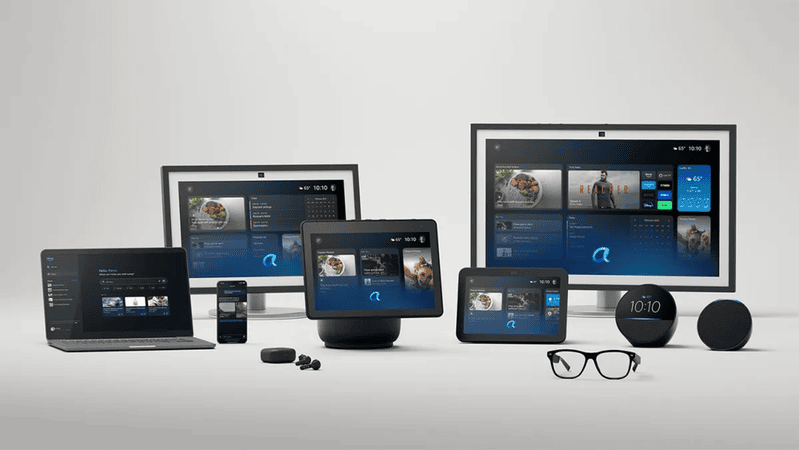
How to Stay Visible in Amazon’s AI-Driven Future
What Is Amazon Rufus and How Does It Help Shoppers?
Rufus is Amazon’s new generative AI-powered shopping assistant, built to enhance product discovery and decision-making. Integrated directly into the Amazon interface — both on mobile and desktop — Rufus allows users to ask free-form questions about products via the “Ask Rufus” button.
Unlike traditional search, which relies on exact keyword matching, Rufus understands natural language queries and the shopping context behind them. It can interpret a customer’s intent, analyze product features, and provide in-depth answers — much like a knowledgeable in-store consultant.
Powered by a large language model (LLM) trained on Amazon’s own product data, Rufus continuously learns and improves based on user interactions. It uses natural language processing (NLP) to parse complex questions and deliver relevant, conversational responses — making it faster and easier for shoppers to find exactly what they need.

What’s New in Alexa+ and How Is It Connected to Rufus?
Alexa+ is Amazon’s next-generation voice assistant, launched in early 2025 and enhanced with generative AI technology. It represents a significant upgrade from the original Alexa, moving beyond basic commands and voice queries.
What sets Alexa+ apart is the integration of a large language model (LLM) — the same foundational technology behind Rufus. This gives Alexa+ the ability to understand voice-based product queries in natural language, access deep product knowledge, and make intelligent shopping recommendations.
By embedding Rufus’s product intelligence into Alexa+, Amazon has effectively merged conversational AI with hands-free voice search, allowing users to discover and evaluate products using nothing more than their voice — across devices like smart speakers, phones, and TVs.
Rufus vs. Alexa+: What’s the Difference, and Which AI Assistant Should You Focus On?
Rufus is embedded directly into Amazon’s mobile app and website, designed specifically to assist with product discovery and in-store search. It helps users ask natural-language questions about features, comparisons, and recommendations — all within the Amazon shopping ecosystem.
Alexa+, on the other hand, is a multifunctional voice assistant integrated into user devices such as smart speakers, phones, and TVs. While it can still handle shopping tasks, it also manages smart home functions, plays media, and performs general queries.
What makes Alexa+ unique in 2025 is that it now leverages the same product intelligence engine as Rufus. In other words, Alexa+ combines the voice interface of classic Alexa with the shopping-specific AI knowledge of Rufus, creating a powerful hybrid assistant for both daily life and commerce.

How Customers Are Using Rufus and Alexa+: Adoption and Trust in AI Shopping
Early data shows that Amazon’s AI-powered tools are quickly gaining traction among users. In the U.S., roughly one in every five or six Amazon searches is already being conducted through Rufus, and that share continues to grow rapidly. While Amazon has yet to release official usage reports, insider estimates are compelling: as of October 2024, Rufus was handling approximately 274 million queries per day, accounting for around 13.7% of all searches on the platform.
By the end of 2025, that number is expected to double, with AI-driven search projected to make up 25–30% of total user queries. The shift signals growing trust in AI recommendations — especially when users see that Rufus relies on verified reviews and detailed product data.
The story with Alexa+ is a bit different. Voice commerce has long remained a niche behavior. Despite over 500–600 million Alexa-enabled devices sold globally, most users still rely on them for music, weather, or home automation — not shopping. Many customers have been hesitant to make purchases without first visually inspecting a product.
How Rufus and Alexa+ Are Changing Buyer Behavior on Amazon
Amazon’s new AI assistants are transforming how customers make purchasing decisions. Shoppers who use Rufus or Alexa+ tend to spend less time browsing and comparing manually — much of the initial research is now handled by the assistant itself.
This shift significantly impacts product visibility. If your listing isn't surfaced or recommended by the AI, it may never reach the buyer’s attention. In an AI-driven shopping flow, only products that are well-structured, informative, and relevant are likely to be presented as top results.
For sellers, this means that being excluded from AI responses is the new Page 2 — and that optimizing for visibility in assistant-driven search is now just as important as ranking in traditional keyword search.
How to Optimize Your Product Listings for Rufus and Alexa+: Tips for Amazon Sellers
The introduction of Rufus and Alexa+ marks a major shift for Amazon sellers. The era of keyword-stuffing is giving way to a new phase of AI-friendly, context-driven content. Where once visibility depended heavily on keyword placement, it now hinges on how clearly and comprehensively your listing communicates value — not just to customers, but also to AI assistants.
To stay competitive in this new environment, sellers need to focus on creating listings that are not only informative and structured, but also easy for AI to interpret and recommend.
Here are the key areas to focus on when optimizing listings for Rufus and Alexa+:
Clear and Detailed Product Descriptions
AI assistants analyze product pages much like human shoppers do. That means your description should be logical, concise, and packed with specific, helpful information. Go beyond generic claims — include materials, use cases, and core benefits. Anticipate common buyer questions and answer them directly in the text.
Complete and Structured Attributes
Rufus pulls from a wide range of product attributes when generating answers: color, size, dimensions, compatibility, wattage, and more. Ensure all key attributes are properly filled out in your Amazon backend and reflected in your listing content. For example: “Compatible with most USB-C laptops” or “Dimensions: 60×40×25 cm, weight: 2.3 kg.”
Natural Language Over Keyword Stuffing
While Amazon's A10 algorithm still uses keywords, Rufus and Alexa+ are powered by large language models (LLMs). These systems respond better to human-friendly, conversational language. Instead of cramming keywords like “cheap 40L trekking backpack,” write something like “Durable 40L hiking backpack — ideal for 3–5 day trips.” Use phrasing that mirrors how real shoppers speak.
Customer Reviews and Ratings as AI Signals
AI tools rely heavily on reviews and ratings to recommend products. Encourage buyers to leave detailed, specific feedback. Statements like “keeps warm during winter walks” can directly appear in Rufus-generated responses. Monitor your Q&A section too — answers to common questions improve both shopper trust and AI comprehension.
Brand Story and Voice Strategy
AI assistants don’t always show brand names prominently, but they still analyze brand-related data. If your brand has a unique selling point or reputation — highlight it in the listing. For example: “Engineered in Germany with over 15 years of orthopedic design experience.” Also ensure that Alexa+ can correctly pronounce your brand name — this matters in voice search. As Amazon evolves, paid placements in AI responses may emerge, making these elements even more critical.
Craft listings that simultaneously:
This balanced approach ensures your product performs well in both traditional search and AI-powered conversations on Amazon.
- Answer real customer questions
- Are structured for AI readability
- Include all relevant specs and visual assets
- Maintain strong human-facing marketing appeal
5 Key Steps to Optimize Your Amazon Listing for Rufus and Alexa+
1. Identify and Answer Common Buyer Questions
To ensure your product is visible to Rufus, think like your customer. What questions are they likely to ask? Create a list of typical queries:
Make sure your product listing includes clear, direct answers to these types of questions — in your description, bullet points, or FAQ section. Rufus pulls responses from multiple areas of your page, so the more structured and explicit your content, the better it can respond.
- “Is this suitable for...?”
- “How loud is it?”
- “What’s the battery life?”
- “What material is it made of?”
2. Refine Your Title and Bullet Points for AI Understanding
Your product title should be short, specific, and informative, including the model name, core function, and standout feature. Bullet points are among the first areas scanned by both Amazon’s A10 algorithm and Rufus. Each point should add clear value. For example:
Avoid keyword stuffing. Instead, focus on clarity, relevance, and usefulness — AI rewards content that mimics real human phrasing.
- “Capacity: 40L — ideal for 3–5 day trips”
- “Battery life: Up to 10 hours on a single charge (5000mAh battery)”
3. Use Amazon’s AI Content Tools Wisely
Amazon now offers built-in AI tools in Seller Central to help generate listing content. These tools are trained on what works within the AI ecosystem, including Rufus. Use them to draft descriptions — but always edit the results to match your brand tone, add detail, and ensure accuracy. Think of AI writing tools as a starting point, not a finished product.
4. Enhance Visual Content: Images & Video Matter
While Rufus is primarily text-based, it can suggest visuals by saying things like “Here’s a photo of the product.” Alexa+ on screens will also show images and videos.
Well-designed visuals improve both buyer engagement and AI interpretation. Some AI models even link to videos in response to customer voice commands — giving you extra exposure.
- Use high-resolution, informative images
- Include infographics, dimension charts, and labeled diagrams
- Add a short video demonstrating the product in use or highlighting key features
5. Monitor Performance & Test AI Responses
Amazon doesn’t yet show specific Rufus metrics, but you can track performance using tools like Search Query Performance and Customer Engagement Reports.
Iterate regularly: refining your listing based on real-time AI behavior is crucial for long-term success.
- Ask Rufus questions about your own product
- See if it recommends your listing or skips it
- If the answer is vague or doesn’t include your SKU — improve your content
Build listings that are rich in structured, buyer-focused information. The more clearly your content answers common shopper questions, the more likely it is to be picked up by Amazon’s AI — driving higher visibility and conversion.
The Future of AI Commerce on Amazon (2025–2026): Key Trends
Voice shopping will finally go mainstream, and AI-powered search is expected to become the new default. As Rufus and Alexa+ continue to evolve, Amazon’s ecosystem will grow even more self-sufficient — minimizing the need for outside search or comparison tools.
For sellers, this shift introduces new rules and new opportunities. Brands that optimize for AI visibility — with structured, relevant, and easily interpreted content — will secure stronger positions in assistant-driven recommendations.Adapting early means staying visible in the age of conversational commerce.
Book a call now…
Book a call now…
Up to 45-min duration video-call
Topics we'll discuss:
| The next steps — there are two options
|
